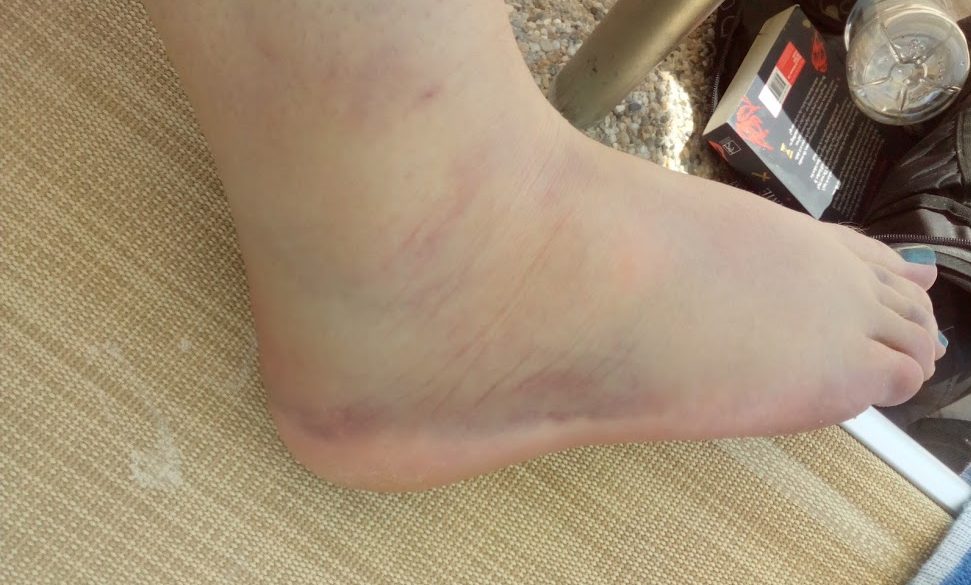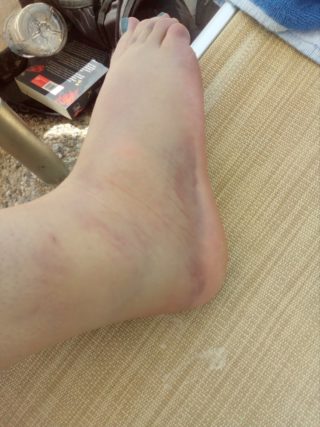Ankle Sprain

The Dreaded Ankle Sprain
By Yvonne Buckley
Ankle sprains are often underestimated until you have one.  In 2017 on holidays in Croatia I was staying in an old guest house with 3 flights of stairs and poorly lit corridors. On the second day of the holiday, in a pair of runners carrying my suitcase downstairs I lost my footing on a corner step and fell. Landing in a contortion at the foot of the stairs. My foot throbbing. I hobbled downstairs clutching onto my friends for support , put my foot up and it had immediately swelled. Luckily my friends were podiatrists also, we all concurred it was a Grade 3 Inversion Ankle sprain. I spent the rest of my holiday hobbling up cobbled streets, being taped up and using copious amounts of Ice. When I came back to Ireland I was lucky enough to have Mary and the girls to look after me, lots of acupuncture and laser helped to speed up the process.
In 2017 on holidays in Croatia I was staying in an old guest house with 3 flights of stairs and poorly lit corridors. On the second day of the holiday, in a pair of runners carrying my suitcase downstairs I lost my footing on a corner step and fell. Landing in a contortion at the foot of the stairs. My foot throbbing. I hobbled downstairs clutching onto my friends for support , put my foot up and it had immediately swelled. Luckily my friends were podiatrists also, we all concurred it was a Grade 3 Inversion Ankle sprain. I spent the rest of my holiday hobbling up cobbled streets, being taped up and using copious amounts of Ice. When I came back to Ireland I was lucky enough to have Mary and the girls to look after me, lots of acupuncture and laser helped to speed up the process.
Some Background
Ankle sprains are surprisingly common. There are about 302,000 new sprains in the UK. I state “new” because the recurrence rates are greater than 70 %. So if you get one it’ll likely happen again. 55% of people don’t seek professional help. I wonder are those 55% all in the recurrence bracket also? Residual effects can be present from 6-18 months after.
How does it happen
For stability ligaments hold your Fibula to your foot. These structures are design to allow a certain level of movement to allow your foot to adapt to terrain. However if the level of tension is exceeded the ligaments are stretched beyond their capacity, this a sprain. There are three categories to define a sprain based on it severity.
A sprain is most commonly done on the outside of your foot, this is because the ligaments on the inside of your foot tend to be far more robust.
Risk factors include Previous Injury , Ligamentous laxity, Activity, and Hypermobility.
An acute ankle sprain will be swollen, tender and painful on movement and weight bearing. If you can avoid weight bearing an apply ice immediately do so.
For our assessment we look at :
- Your symptoms and history
- The range of motion currently present
- Your balance
- Ability to undertake functional tasks
- Muscle Strength
As part of our treatment plan we may ask you to reduce aggravating factors such as activity levels.
Low Level Laser will help reduce pain levels and speed up healing, a few sessions of laser may be recommended. We often combine taping with laser, taping offers compression , to reduce swelling and to give additional support to your ankle. See more about Lower Limb Arthritis and the effectiveness of Soft Tissue Laser and Foot Orthoses
Rehabilitation will include balance training, landing tests or whatever is relevant to your activity levels.
Joint mobilisation and taping may be suggested.
Orthotic therapy – bracing or foot orthoses may be suggested to provide the necessary support.
The rehabilitation after an ankle sprain is really important, because if you don’t build up strength gradually you will be more likely to see a recurrence and it can delay healing time.
From personal experience the treatment modalities here in Mary Moore Podiatry really helped me get back on my feet, between acupuncture and regular laser I was back to my regular self in no time. As an active person it’s hard feeling so debilitated but if you have an ankle sprain, don’t delay call a podiatrist ASAP.




